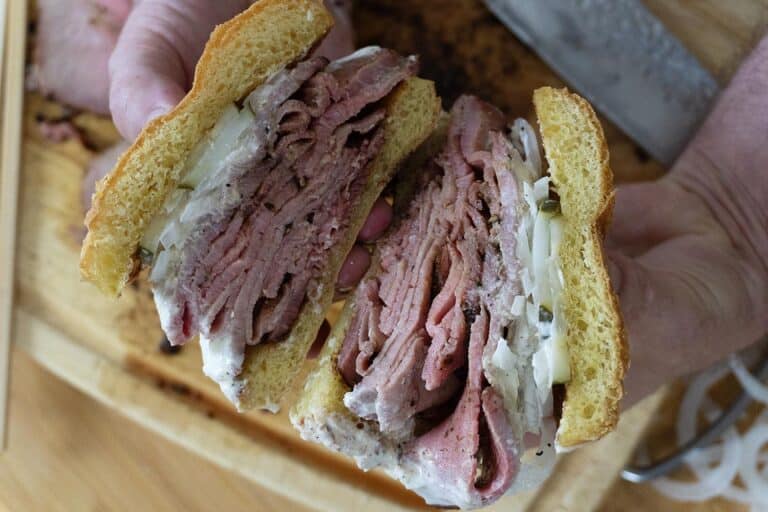Steamed Burgers
Central Connecticut makes their burgers with a twist- by steaming the burger and cheese separately for a deliciously juicy steamed burger.

When it comes to iconic American foods, burgers often take center stage. They’re a quintessential part of American cuisine, but have you ever heard of a steamed burger?
Well, if you’re a burger aficionado, Connecticut’s steamed burgers are the way to go. These juicy burgers are popular in Central Connecticut.
Today, we’ll dive into the world of the steamed burger, including their history, the best places to try them, and some commonly asked questions.
Looking to try unique sandwiches from around the country? Try out the viral Vermonter, the Pueblo Slopper from Colorado, or Alabama’s delectable white bbq sauce on a Pulled Chicken Sandwich.
The Birth of the Steamed Burger
Steamed burgers, sometimes referred to as steamed cheeseburgers, have a special place in the heart of Connecticut. They were invented in the heart of this New England state, New Haven to be exact. This delightful culinary creation has a history dating back to the 20th century, making it a true Connecticut original.
The Magic of Ted’s Steamed Burger
If you’re in Connecticut and eager to try an authentic steamed cheeseburger, Ted’s is the place to be. Located in Meriden, Ted’s Restaurant has gained legendary status for its perfectly steamed burgers.
They use a unique method of cooking where the meat is steamed over a bed of bubbling cheese. As the meat cooks, the cheese melts and is scraped onto the burger, creating a mouthwatering, gooey layer of goodness. When it comes to the cheese used, Ted’s typically uses a local white cheddar, adding to the burger’s rich and creamy flavor.

Steaming vs. Grilling: Healthier or Not?
One question that often comes up is whether steamed burgers are healthier than their grilled counterparts. Steaming, in general, is considered a healthier cooking method as it doesn’t involve adding extra fats or oils, and it helps retain the meat’s natural juices.
However, the overall healthiness of a burger depends on factors like the type of meat used and portion size. Steamed burgers may have a slight edge in the health department, but ultimately, it’s all about moderation and the ingredients used.
The Cheeseburger Capital of the United States
Connecticut proudly claims the title of the cheeseburger capital of the United States, and for a good reason. Steamed cheeseburgers are a culinary treasure unique to the state. They’ve become a symbol of Connecticut’s rich food culture and innovation in burger-making. While burgers can be found throughout the country, steamed cheeseburgers remain a regional specialty that’s well worth a try for anyone visiting the area.
Invention of the Cheeseburger
The invention of the cheeseburger itself is often attributed to Lionel Sternberger, who supposedly first added a slice of cheese to a burger at his father’s Pasadena, California, restaurant in the 1920s. However, steamed cheeseburgers, as we know them today, have their roots firmly planted in the state of Connecticut.
A Delicious Connecticut Tradition
Steamed burgers are more than just a delightful twist on the classic hamburger.
They represent the rich culinary history and innovation of Connecticut. When you’re in the Nutmeg State, make sure to savor this unique and delicious treat.
Steamed cheeseburgers are not only a must-try for burger enthusiasts but also a delightful piece of Connecticut’s gastronomic heritage.

What kind of cheese does Ted’s steamed cheeseburgers use?
Ted’s typically uses a local white cheddar cheese to create their iconic steamed cheeseburgers.
Where was the steamed burger invented?
Steamed cheeseburgers were invented in New Haven, Connecticut.
Are steamed burgers healthier?
Steamed burgers are considered a healthier option compared to grilled ones because they are cooked without additional fats or oils.
Can you actually steam hamburgers?
Yes, you can steam hamburgers, and it’s a cooking method that’s particularly popular in Connecticut.
Are steamed cheeseburgers good?
Steamed cheeseburgers are highly regarded for their unique and delicious flavor, making them a must-try for burger enthusiasts.
What state invented the cheeseburger?
The invention of the cheeseburger is often attributed to California, specifically Pasadena, where a restaurant owner named Lionel Sternberger added a slice of cheese to a burger in the 1920s.
Where was the hamburger invented Connecticut?
While the exact origin of the hamburger is debated, the modern concept of the hamburger is closely associated with New Haven, Connecticut, where steamed cheeseburgers were developed.
Who made the first cheeseburger in the United States?
Lionel Sternberger is often credited with making the first cheeseburger in the United States by adding a slice of cheese to a burger at his family’s restaurant in Pasadena, California.
What is the cheeseburger capital of the United States?
Connecticut is often referred to as the cheeseburger capital of the United States due to its unique steamed cheeseburger tradition.
- 1 steamer pot
- ⅓ lb ground chuck
- salt and pepper
- 2 1 inch cubes of white cheddar cheese
- 1 bun
- mayo
- mustard
- onion slices
- lettuce
- tomato slices
- Form beef into one evenly shaped patty. Season each side with salt and pepper.
- Fill a pot halfway with water. Place steamer basket on top and place on a burner. Set to high and bring water to a boil.
- Place cheese cubes in a ramekin cup safe to use. Carefully place cheese cup and burger into the steamer basket. Cover with the lid. Cook until medium rare at 130 F, about 10 minutes. Use thermometer to check for doneness.
- Carefully remove the cheese cup and burger with tongs. Allow burger to rest for a minute.
- Place burger on bottom bun and use a knife to scrape out melted cheese onto burger. Top with desired toppings- onion, lettuce, tomato, mayo and mustard.







